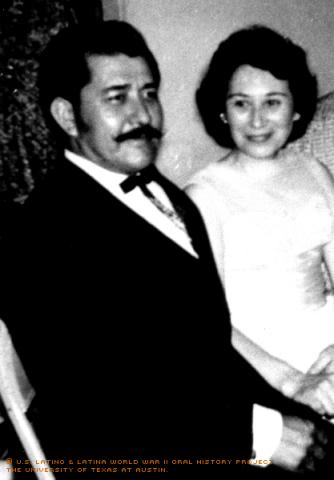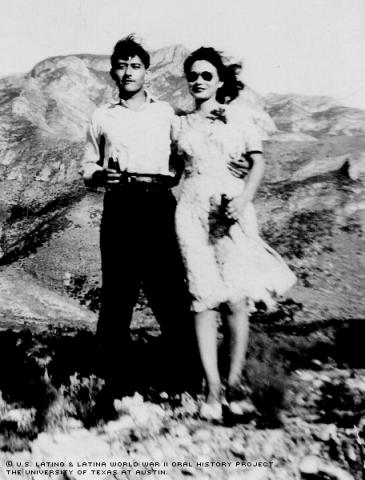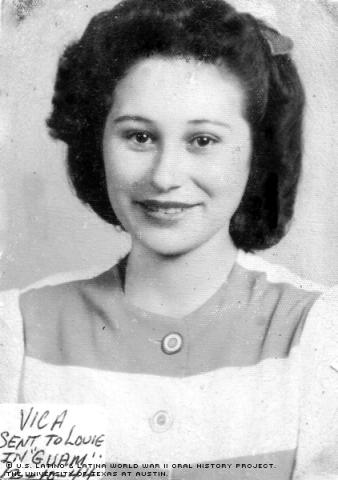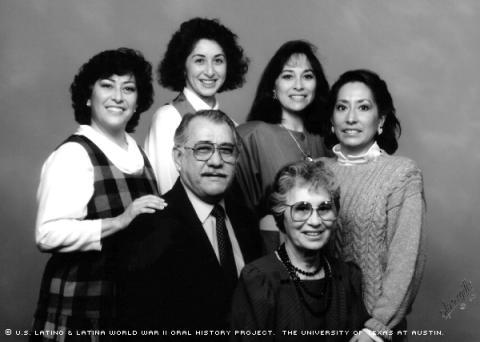



By Christa Desimone
She remembers the telephone call like it was yesterday. A man had rushed into the office where she was working in May of 1946, yelling to her that she had a phone call waiting for her across the street.
Victoria Partida dashed to the phone and heard the voice of the man from whom she’d been waiting to hear for two long years. It was her fiancé, Luis Guerrero, who’d been at war in the South Pacific. He said the words she’d long wanted to hear.
"You'd better get ready, because I'm coming down," he told her. He’d been discharged from the Marines a few weeks earlier, on May 30, 1946. The two were to finally be married after years of separation by World War II.
Victoria Partida Guerrero grew up in the South Texas Rio Grande Valley, where she remembers everyone being friendly and knowing everyone else.
Her father, Narciso Partida, died when she was 3, and her mother, Eulogia Guerra Partida, remarried a few years later. The family worked in the fields to harvest spinach, potatoes, carrots and cotton.
"It was hard working out in the hot sun," Guerrero said. "It was hard, but we were happy. We were poor, but very happy because we shared each other."
For entertainment, her mother would sing while a neighbor played the guitar. Guerrero also enjoyed listening to her grandmother tell stories, especially Spanish versions of Snow White and Cinderella.
At 9, she entered first grade at Fort Sam Houston, but was then skipped to the third grade.
"I don't know whether we were smart, or they just wanted to get rid of us," she said.
As a very shy young girl, it was difficult at first.
"Some of the white girls were nice, others were not very nice," Guerrero said, "After a while, we mingled and got along."
Guerrero says her teacher worked to get the Latino and white children to relate to one another, and that she was comfortable associating with white students by her late teens.
Guerrero met Luis in 1941 while traveling on a train. She was 16 at the time and traveling with family, headed for the sugar beet fields of Michigan. The train stopped in San Antonio, Texas, so migrant workers could be screened for tuberculosis.
While the train was in San Antonio, Luis had pulled his cousin aside, pointed to the future Mrs. Guerrero and said, "See that girl? That's the girl I'm going to marry!"
After moving to Saginaw, Mich., Luis asked Guerrero’s father for permission to court her, and the two began dating regularly, always chaperoned by her younger brother, Pedro.
The couple worked hard to save money to start a life together, but WWII postponed their plans.
Luis enlisted in the Marines in 1943. The oldest child in his family of 15, he was trained as a cannonier. He was sent to Guam in 1944 as a member of the 3rd Marine Division, which took part in Operation Forager, the invasion of Saipan, Tinian and Guam in the Mariana Islands.
Later, Luis spent time in Tiensing, China.
"We wrote back and forth all the time," Guerrero said. "The fear [that he could be wounded or killed] was within you constantly."
She and her mother, aunts and cousins hoped and prayed all the time that their loved ones would return home safely.
"We prayed for peace, we prayed night and day," Guerrero said.
Her family would listen on the radio to reports of those killed or wounded in action. Two of her cousins were killed, one as a gunner in an Air Corps warplane and the other when his tank exploded.
"That's when you pray the hardest," she said. "It was very hard for our families."
She says she attended the funeral of one cousin in Brownsville, Texas, with her family in 1945. The remains had been shipped back to the family in a casket, with orders that it not be opened. She remembers two sentries taking turns standing by the casket, even in the family's home.
"My aunt said, 'Maybe it's just a casket,' " Guerrero recalled.
The war years were hard ones for the family. Clothing, shoes, sugar, coffee and meat were all rationed. Only a certain amount of gasoline was allotted per month for their Model A car, limiting travel. The family worked hard harvesting crops to feed the nation and the troops overseas.
At one point during the family's years in Michigan, German prisoners of war worked in the sugar beet fields with them. They had the letters "POW" printed on their shirts, and Guerrero remembers some of them as "great big husky fellas."
She recalls being a bit afraid of the POWs escaping, but there were no problems while she was there.
Luis loved to take pictures and brought some home that he’d taken during his time in Guam and China. He was aboard the USS Missouri in Tokyo Bay on Sept. 2, 1945, when Gen. Douglas MacArthur signed the formal surrender documents of Japan, and has a picture of the historic moment.
Guerrero describes her husband as a quiet, intelligent man, serious about everything and a perfectionist. He would seldom talk about his war experiences, she says.
The two were married June 23, 1946, in La Feria, Texas. It wasn’t a big wedding, she says, because they didn’t have the financial means at the time. She bought a simple white wedding dress; he was dressed in a Marine uniform.
The couple settled in Raymondville, Texas, for one year, where Luis hauled pipe for oil pipelines on 18-wheeler trucks.
After their daughter, Ester, was born on April 7, 1947, the couple returned to Michigan and moved in with Luis’ family in Saginaw.
"They welcomed me as another child into the family," said Guerrero of her husband's family. The three lived with his family until they could afford their own home.
Luis worked in a steel mill that had produced machine guns and cannon parts during the war and then produced automobile parts. Eventually, he quit that job and returned to his first love, trucks, working for Bender & Louden Motor Freight Co.
They had a second child, Diane, while in Michigan. Two other daughters, Patricia Ann and Catherine Gloria, followed.
Luis died Dec. 19, 1989.
For Guerrero and her husband, hard work had always been a way of life. WWII had an effect on them both as young people and for the rest of their lives, she says.
"He always said, 'I can go anywhere I want to go. I'll go in and they'll let me in.' He was like that, and it made a difference," Guerrero said. "In those years you matured quite early."
Mrs. Guerrero was interviewed in Saginaw, Michigan, on October 19, 2002, by Elizabeth Aguirre.

